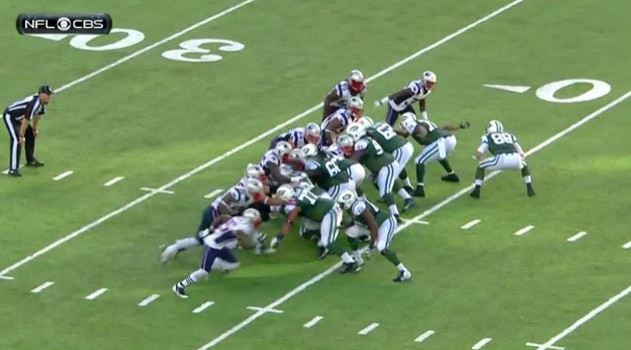'Push Rule' Conspiracy Theory? NFL Did Not Alter Controversial Rule After Jets-Patriots Game, Despite Reports

An obscure new NFL statute known as the “Push Rule” played a crucial role in the New England Patriots’ overtime loss to the New York Jets on Sunday. However, there is no truth to a growing conspiracy theory that the NFL altered the definition of the rule after the game to “cover its tracks.”
The Jets and Patriots were tied 27-27 in overtime when kicker Nick Folk attempted a 56-yard field goal. Folk missed the kick, but not before Patriots special teams player Chris Jones pushed a teammate through the Jets offensive line; as of this past offseason, that type of “push” is against NFL rules. As a result, the Patriots were assessed a 15-yard penalty, allowing Folk to successfully attempt a game-winning field goal.
The “conspiracy theory” surrounding the implementation of the “push rule” stems from a Sept. 3 article on NFL.com that attempted to describe the rule. Before the game, a key phrase in the article read: “Team B players not on the line of scrimmage at the snap cannot push players on the line of scrimmage into the offensive formation." Deadspin points out that the article was the top Google search result for the "push rule."
However, the article appears to have been altered shortly after the game. The new sentence read, “Team B players cannot push teammates on the line of scrimmage into the offensive formation." The slight yet crucial change in the rule’s wording caused some Patriots fans to accuse the NFL of altering the rule after the fact in order to substantiate the on-field ruling.
Several news outlets picked up on the article change. CSN New England reporter Tom E. Curran posted a screenshot of the article on Twitter, and popular sports blog Barstool Sports uploaded a post that accused the NFL of doctoring its own rule.
At the postgame press conference, when Patriots head coach Bill Belichick stated his belief that the game’s officials had misinterpreted the push rule. “You can’t push on the second level. I didn’t think we did that,” he told reporters after the game.
Despite the accusations of alleged misdeeds by the NFL, Deadspin's Barry Petchesky points out that the league never altered the wording of the rule in the one place where the wording actually matters -- the NFL rulebook. According to the rulebook, the push rule, also known as rule 9.1.3(b)(2), reads as follows:
(b) When Team A presents a field-goal or Try Kick formation:
(2) Team B players cannot push teammates on the line of scrimmage into the offensive formation.
In other words, the NFL.com article’s inclusion of the phrase “second level” -- which refers to the group of players directly behind the line of scrimmage -- was purely an editorial decision on the part of the website’s editors, and has nothing to do with the official NFL rule.
Furthermore, the player who does the pushing is irrelevant -- the push rule is enacted based solely on the location of the player who was pushed. In this case, Jones pushed teammate, Will Svitek, through the Jets’ offensive line. A 15-yard penalty was called because Svitek was on the line of scrimmage.
Moreover, Jones himself admitted after the game that he had done something illegal. "Yeah, it was something we talked about probably during camp and stuff, and it just slipped out of my mind. So I just, it was just my mistake, nobody else's. I've just got to man up and fix it next time,” he told reporters.
So, while the league’s first-ever use of the “push rule” was controversial, it certainly wasn’t evidence of a league-wide conspiracy against the Patriots.
© Copyright IBTimes 2024. All rights reserved.












